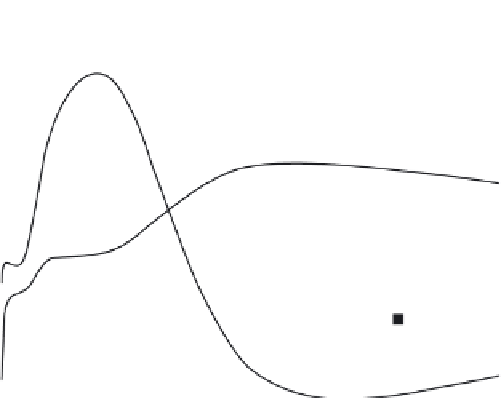Agriculture Reference
In-Depth Information
LSD
LSD
1-MCP concentration (nl/l )
Figure 11.1
Effects of 1-MCP treatments (0 [control], 10, 100, 250, 500 or 1000 nl l
−
1
) for 2 h at 20°C on
strawberry fruit post-harvest life (hand firmness; •) and number of hours to 10% disease severity (
■
). Data
are means for 15 fruit. LSDs (P
=
0.05) are presented. (Jiang
et al
., 2001, with permission.)
soluble sugar, acidity, health-related compounds (
viz
. antho-
cyanins and other phenylpropanoids) and aroma occur.
and norbornadiene (NBD) failed to block anthocyanin
accumulation in developing strawberry fruit (Given
et al
.
1988). Tian
et al
. (1997) showed that application of the
ethylene binding inhibitor diazocyclopentadiene (DACP)
increased ethylene production, but not respiration, of ripe
strawberry fruit. Enhanced ethylene production was
explained as release from feedback inhibition on ACC
synthesis. Despite this lack of evidence that soft fruit are
ethylene-sensitive, exogenous ethylene can enhance the
growth of
B. cinerea
on strawberry and decrease fruit
firmness (El-Kazzaz
et al
. 1983). Curd (1988) showed that
strawberries exposed to ethylene had more intense red
colour than those stored in ethylene-free air. Moreover,
exogenous ethylene induced secondary ripening processes
(e.g. colour development, softening) in strawberry fruit
(Tian
et al
. 2000). Wills and Kim (1995) found that use of
the ethylene absorbent potassium permanganate extended
the storage life of strawberries. Thus, it follows that
prevention of ethylene production and/or inhibition of
ethylene action could be an approach to extending the
post-harvest longevity of ripe strawberry fruit. However,
post-harvest treatments with 1-methylcyclopropene
(1-MCP), the ethylene binding inhibitor, have been shown
to have both beneficial and/or detrimental effects on
strawberry fruit quality (Figure 11.1 and Table 11.6). Work
Hormonal control
Ripening in most fruits is associated with either a decrease
in auxin or an increase in ethylene production. However,
the strawberry and other soft fruit are generally regarded
as nonclimacteric in their respiratory behaviour (Lipe
1978; Given
et al
. 1988; Perkins-Veazie & Nonnecke
1992; Burdon & Sexton, 1993; Perkins-Veazie
et al
. 2000)
exhibiting little respiratory increase after harvest. In
general, ethylene is considered to have little or no effect on
ripening of soft fruit. For instance, Siriphanich (1980)
found no differences between strawberry fruit held in air
or 100 μl l
−1
ethylene. On the other hand, Knee
et al
. (1977)
and Abeles and Takeda (1990) highlighted the correlation
between endogenous ethylene production and the ripening
process. Typically, strawberry fruit are unresponsive to
exogenous ethylene (Iwata
et al
. 1969; Hoad & Williams
1971). However, Perkins-Veazie and Huber (1987)
demonstrated that colour development could be stimulated
by using the ethylene analogue propylene (5000 μl l
−1
).
Application of the ACC (1-aminocyclopropane-1-carboxylic
acid)-synthase inhibitor aminoethoxyvinylglycine and
the ethylene binding inhibitors silver thiosulfate (STS)
































































